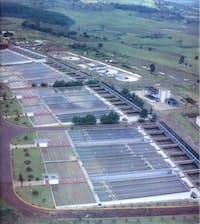Located about 125 kilometers (78 miles) west of Mexico City lies the municipality of Villa de Allende, home of Mexico's largest potable water treatment plant. The National Water Commission (Conagua), an agency of the Mexican government that manages the nation's drinking water and wastewater treatment, constructed the Los Berros water treatment plant in 1980. The plant provides 1.5 billion liters per day (396.3 million gal per day) of water to Mexico City, which is approximately 25 percent of the total water that is supplied to the metropolitan area, the western hemisphere's most populace.
Part of the Cutzamala River system, the treatment plant draws water from seven reservoirs and pumps it to Mexico City via a 127-kilometer (79-mile) aqueduct. Its treatment capacity is 24 cu meters per second (547 mgd). Los Berros consists of a tank for reception of raw wastewater, filters, chlorine dosing, a Parshall meter (where the coagulant is applied), flocculation, sedimentation and filtration. The original plant filtration system incorporated a nozzle underdrain system, which included five modules of 40 double bays.
Underdrain system experiences poor backwash water distribution
In 2010, Conagua decided to replace the nozzle underdrain system at Los Berros. The plant had experienced poor backwash water distribution as well as frequent nozzle breakages. This caused significant loss of sand media, which usually ended up in the sedimentation tanks. Replacing the lost media and emptying the sedimentation tanks, which wasted vast amounts of valuable water, had become a costly proposition. Conagua decided that refurbishment of the filter underdrain and replacement of the media were required. In searching for a new filter underdrain system, the agency sought a more reliable solution that would provide for better air and water distribution during the backwash operation and would not require frequent parts replacement.
After investigating a number of filter underdrain systems, Conagua selected the TETRA LP Block low-profile dual parallel lateral filter underdrain blocks with the GroutGrip design from De Nora Water Technologies. The installation also included sludge collectors and fiberglass reinforced plastic troughs for eight sedimentation basins and eight new double-bay filters. A total of 96 new filters were installed, providing 7,834 sq meters (25,696 sq ft) of filtration capacity. Commissioning of the refurbished plant occurred in March 2012. The consulting engineer for the project was Servicios y Consultores S.C. (SEYCO) of Morelia, Mexico.
Benefits of the LP Block technology
The LP Block provides superior distribution for both water and air, sequentially or concurrently. The blocks cover the floor of the gravity filters, supporting the filter media. Air is distributed evenly across the entire filter bottom area to scour the media and to provide an air lift which, with the water, removes the released solids from the media. This dual backwash action provides intense and extremely effective backwashing of the filter media. Importantly, the nozzleless design ensures there are no blockages that could potentially affect the performance of the filter. And the system's absence of moving parts eliminates wear and tear.
TETRA LP blocks have become popular with plant owners throughout the world for their low profile, low head loss and easy installation, either as a retrofit or for new filter underdrain applications. The robust yet lightweight blocks are injection-molded and made from high-density polyethylene. They are easy to assemble and ensure superior distribution of both air and water for effective backwash, exceptional installation strength and maintenance-free life.
The GroutGrip design helps to alleviate the buoyancy inherent in conventional filter underdrain block designs. In fact, the LP Block features a pullout strength that is 1.75 times that of a conventional filter underdrain block design. Additionally, the wide, low-profile design requires the installation of fewer blocks to cover a filter floor. Therefore, fewer joints are created and less grout is needed.
"The LP block is about 13 cm [8 in.] lower than the plant's previous underdrain system, which prevents the loss of media during backwash," said Virgilio Martinez, regional manager for De Nora Water Technologies. "The lower profile also increases hydraulic head during filtration. The system does not require pumps or elevated tanks often needed with some other systems, so it requires less power for operation."
"Conagua performed a careful and complete analysis of available underdrain technologies, and we compared the advantages and disadvantages of each," said Juan Daniel McNaught, manager of water and wastewater distribution for Conagua. "With the TETRA LP Block technology, we believe we have made the best choice in terms of performance and cost and based upon the structural requirements and functionality of the Los Berros plant."



